At a glance
Expert’s Rating
Pros
・Incredibly lightweight
・Ceraluminum is impressive
・Mind-blowing battery life
Cons
· A $600 laptop processor in a $1,200 device
• Seriously, this is the most sluggish Snapdragon X chipset I’ve come across.
・The ceraluminum has an almost plastic-like and hollow feel
Our Verdict
The Asus ZenBook A14 serves as a remarkable demonstration of what makes a laptop both lightweight and enduring. However, consider this: you should only purchase it if you’re prepared to compromise on performance for the sake of having a super-light device with longer battery life than you might typically require.
Price When Reviewed
The value displayed here represents the geo-located pricing information for an unspecified product.
Best Pricing Today
Price When Reviewed
$1,200
Top Deals of the Day: Asus ZenBook A14
Retailer Price Asus $1199.99
View Deal

$1199.99
View Deal
Product price comparisons sourced from more than 24,000 global retailers via Backmarket.
The
Asus ZenBook A14
It’s an intriguing device. The frame is constructed from “Ceraluminum,” making it extremely lightweight yet robust. Weighing in at slightly more than two pounds, it boasts impressive battery performance. Nonetheless, Asus opted for the sluggish Qualcomm Snapdragon X processor within this unit.
The ZenBook A14, priced at $1,200, utilizes a Snapdragon X processor that was initially designed for
$600 laptops
While this laptop provides an extended battery life, I’m uncertain whether the trade-offs justify the cost.
everyday tasks
A more powerful Snapdragon X chipset could provide enhanced performance (usually at a reduced cost)! However, if you’re content with Windows on ARM and prioritize battery life above all else, this device may suit your needs perfectly. Still, it caters to quite a specific audience.
Asus ZenBook A14: Specs
The Asus ZenBook A14 comes equipped with a Qualcomm Snapdragon X processor. Our review focused on the UX3407QA version, priced at around $1,200. The device includes a Qualcomm Snapdragon X X1-26-100 processor.
This is essentially a new, more accessible Snapdragon X chipset. It’s
slower
than the original Snapdragon X Plus processors, which were the least speedy among them. Here’s
the official product matrix
As evident, the Snapdragon X ranks lowest due to its slower CPU (up to 3 GHz) and GPU (1.7 TFLOPs). However, this also implies lower power consumption and potentially improved battery life. It’s worth noting that Snapdragon X processors typically excel in these areas. Nevertheless, this level of performance seems inadequate for a device priced at $1,200.
Although I’m informed that tariffs are impacting prices, this situation remains so.
much
We wouldn’t anticipate seeing a laptop equipped with this chipset selling for more than that price point. Qualcomm pledged notebooks priced around $600 featuring this processor, yet Asus utilized it to produce a model lasting longer at an increased cost of approximately $1,200.
・
Model number
: UX3407QA
・
CPU:
Qualcomm Snapdragon X X1-26-100
・
Memory:
32 GB LPDDR5X
・
Graphics/GPU:
Qualcomm Adreno
・
NPU
Qualcomm Hexagon (45 tera-operations per second)
・
Display:
1920×1200 OLED screen featuring a 60Hz refresh rate
・
Storage:
1 Terabyte PCI Express 4.0 Solid State Drive
・
Webcam:
1080p webcam
・
Connectivity:
2x USB Type-C ports supporting USB 4.0 Gen 3, 1x USB Type-A port with USB 3.2 Gen 2 capability, 1x HDMI 2.1 output port, and 1x combined audio jack.
・
Networking:
Wi-Fi 6E, Bluetooth 5.3
・
Biometrics:
Infrared camera for face identification
・
Battery capacity:
70 Watt-hours
・
Dimensions:
12.23 inches x 8.42 inches x 0.53 inches
・
Weight:
2.16 pounds
・
MSRP:
$1,200 as tested
The Asus ZenBook stands out technologically due to its extremely lightweight design and exceptional battery life.
The Asus ZenBook A14: Construction and Craftsmanship
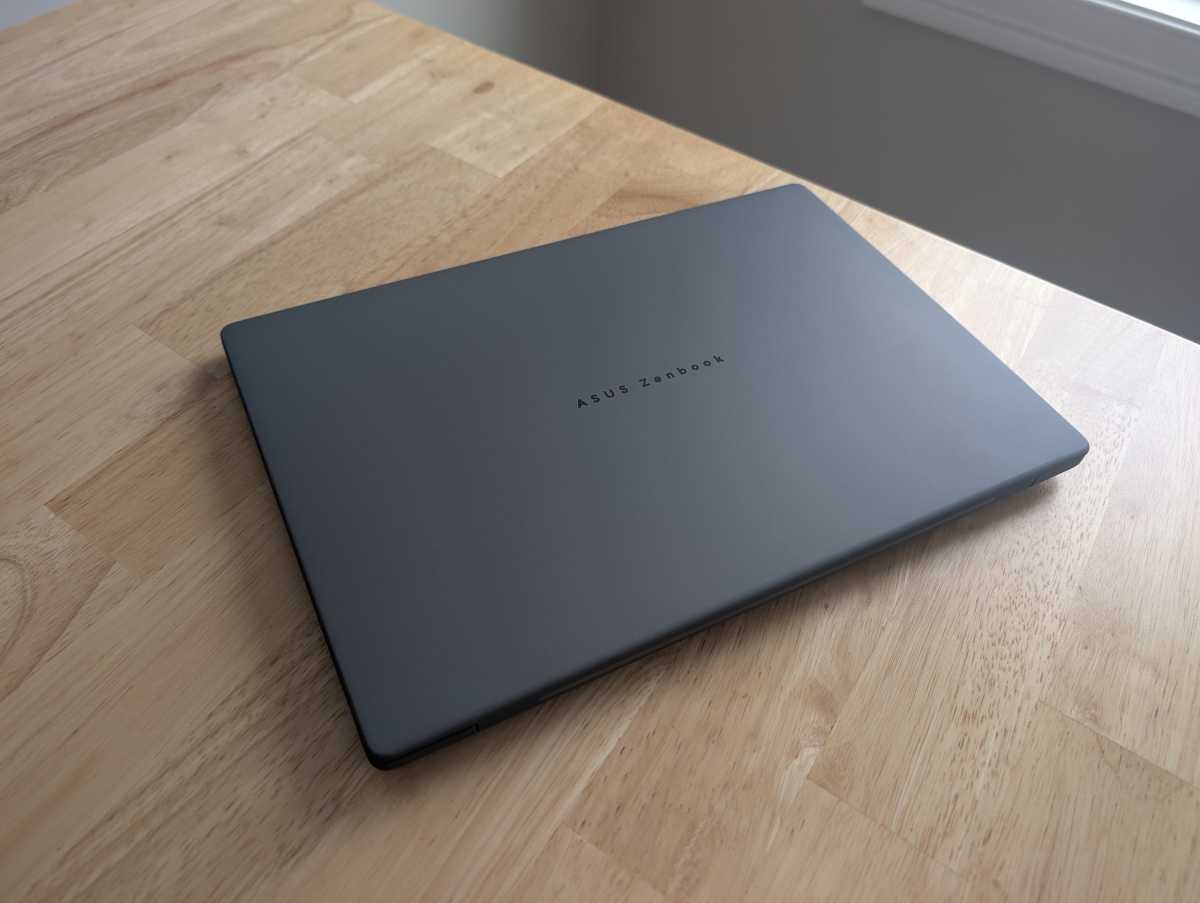
IDG / Chris Hoffman
The Asus ZenBook A14 is remarkably lightweight. Weighing only 2.16 pounds, lifting it feels nearly as though you’re handling an empty device.
That’s because of “Ceraluminum,” the so-called “innovative material” being showcased by Asus. This refers to an aluminum surface treated with a ceramic coating, according to Asus, blending the lightweight nature of aluminum with the durability of ceramic. The device is impressively light! Although Asus claims it’s also robust, I must mention that my testing did not include attempts to damage or drop the unit for such purposes.
The Ceraluminum is intriguing. It doesn’t have the usual metallic feel—it’s more akin to touching ceramics. While it isn’t flimsy, holding it brings to mind lifting a plastic laptop due to its lightweight nature; it feels nearly as insubstantial as one.
hollow
The plastic construction of this laptop might make you think about “premium” metal devices at first. Although there is some metal beneath the exterior, it doesn’t provide that solid metallic sensation. This device may not appeal to those who prefer heavy-duty metal laptops. However, if your preference leans towards lightweight machines, then this one stands out. Overcoming the absence of an obvious metal texture could allow you to appreciate how unusually light it feels compared to similar models with comparable capabilities. Quite remarkable indeed!
That part is the most remarkable. Everything else about the device is typical — but in an excellent manner! You can get this model in “Iceland Gray” with a black trim for both the bezel and hinge. Opening the laptop single-handedly is quite simple. Additionally, it has a pleasant weight when held, perhaps surprisingly so.
too
If you lean towards a more substantial feel, opt for the heavier version. However, it’s lighter than what I typically anticipate from a practical laptop.
Asus ZenBook A14: Keyboards and Touchpads
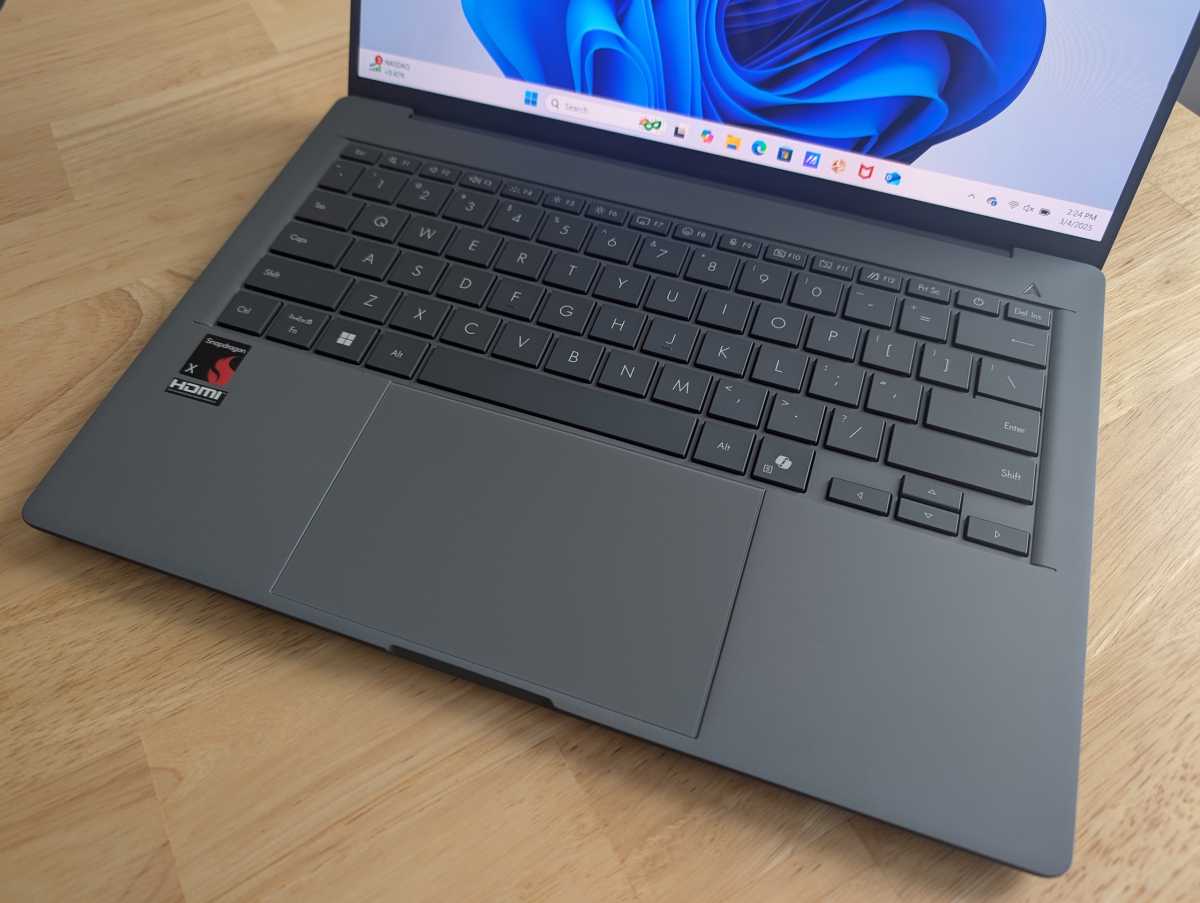
IDG / Chris Hoffman
The keyboard and touchpad of the Asus ZenBook A14 are adequate. While they aren’t exceptionally remarkable, they are definitely functional.
The keyboard offers 1.3mm of keystroke depth. It feels somewhat soft and does not have the same sharp response as you might find on a typical ThinkPad keyboard. However, considering this device aims to be lightweight and slim, the keyboard performs quite well.
The trackpad boasts an optimal size and position just beneath the keyboard. Its smooth surface allows for effortless gliding of your fingers, accompanied by a satisfying “click” sound upon pressing. Typically, I’d still favor a different design, but overall, this one works well.
haptic touchpad
To increase the area of the trackpad that can be clicked.
Asus ZenBook A14: Screen and audio devices
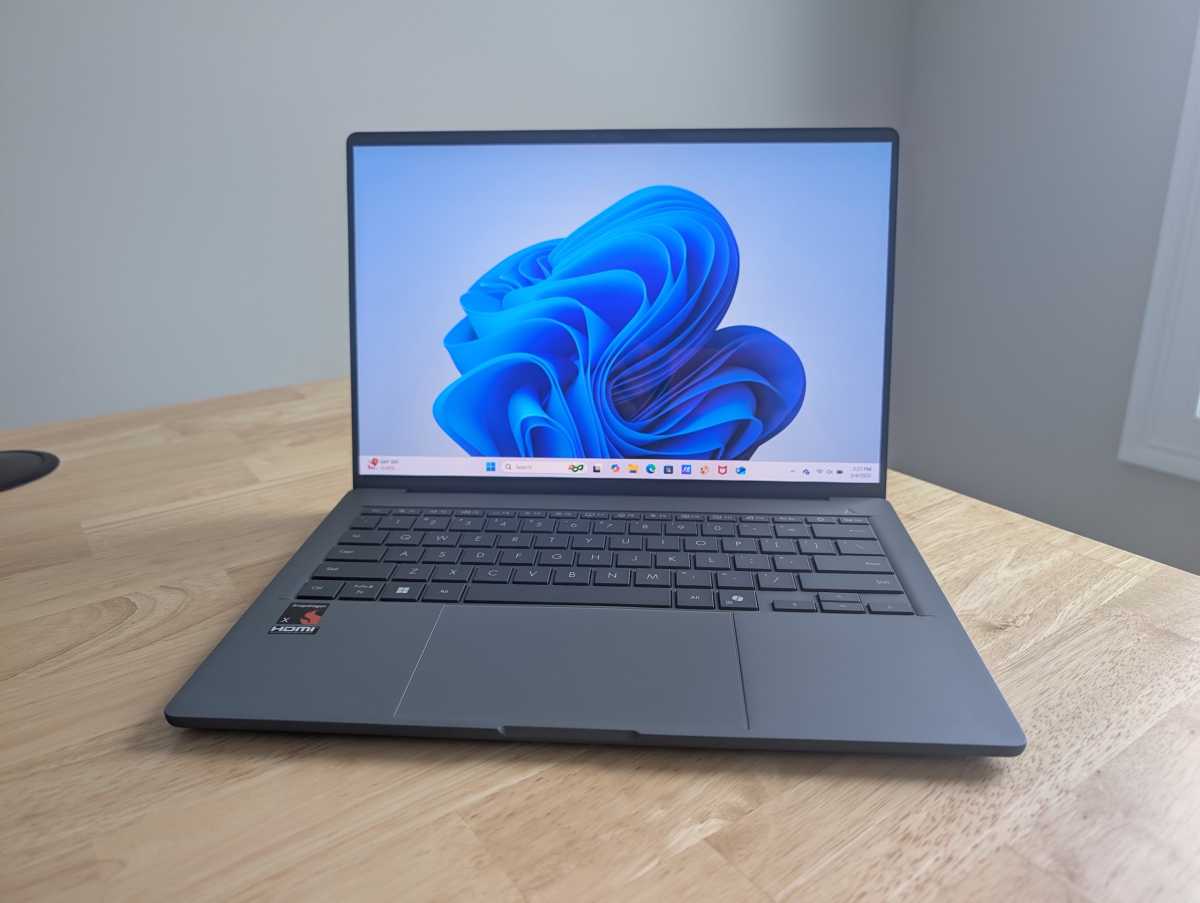
IDG / Chris Hoffman
The Asus ZenBook A14 features a satisfactory screen. The company opted for a 14-inch OLED panel with a resolution of 1920×1200 pixels. It appears quite good; I am fond of OLED displays indeed!
On the contrary, this screen only accommodates a 60Hz refresh rate. While I realize that increasing the refresh rate could reduce battery life, this seems suboptimal.
exactly
The ideal specifications for a $1,200 laptop aren’t solely defined by CPU performance. Given that it has a CPU typically found in a $600 laptop, one should expect additional features such as an outstanding display to compensate. Additionally, it’s important to mention that this is
not
a touchscreen display.
The speakers on this device produce ample sound volume, making them suitable for video conferences and streaming YouTube content. However, I find the bass quality rather disappointing—though perhaps not unexpected. It wouldn’t be reasonable to expect top-notch low-frequency performance from a $1,200 ultralight laptop. Consider bringing along some headphones for listening to music, watching movies, and enjoying TV series.
Asus ZenBook A14: Camera, mic, fingerprint reader
The Asus ZenBook A14 features a 1080p webcam that delivers surprisingly clear images. While it may not be flawless, it certainly outperforms the typical standard. This will make virtual conferences quite enjoyable. However, do keep in mind that it lacks a physical privacy shutter.
The microphone performs well enough for meetings, though I’ve experienced sharper sound quality from microphones on other devices. However, this one suffices. The primary aim of this device isn’t to be the pinnacle of video conferencing solutions; it simply needs to have an adequate microphone.
Asus did incorporate an infrared camera for
Windows Hello
Sign in right away, and it functions quite effectively. You can effortlessly log onto your computer simply by powering on this device or taking a seat in front of it. (Note that there isn’t a fingerprint scanner included though.)
Asus ZenBook A14: Connectivity
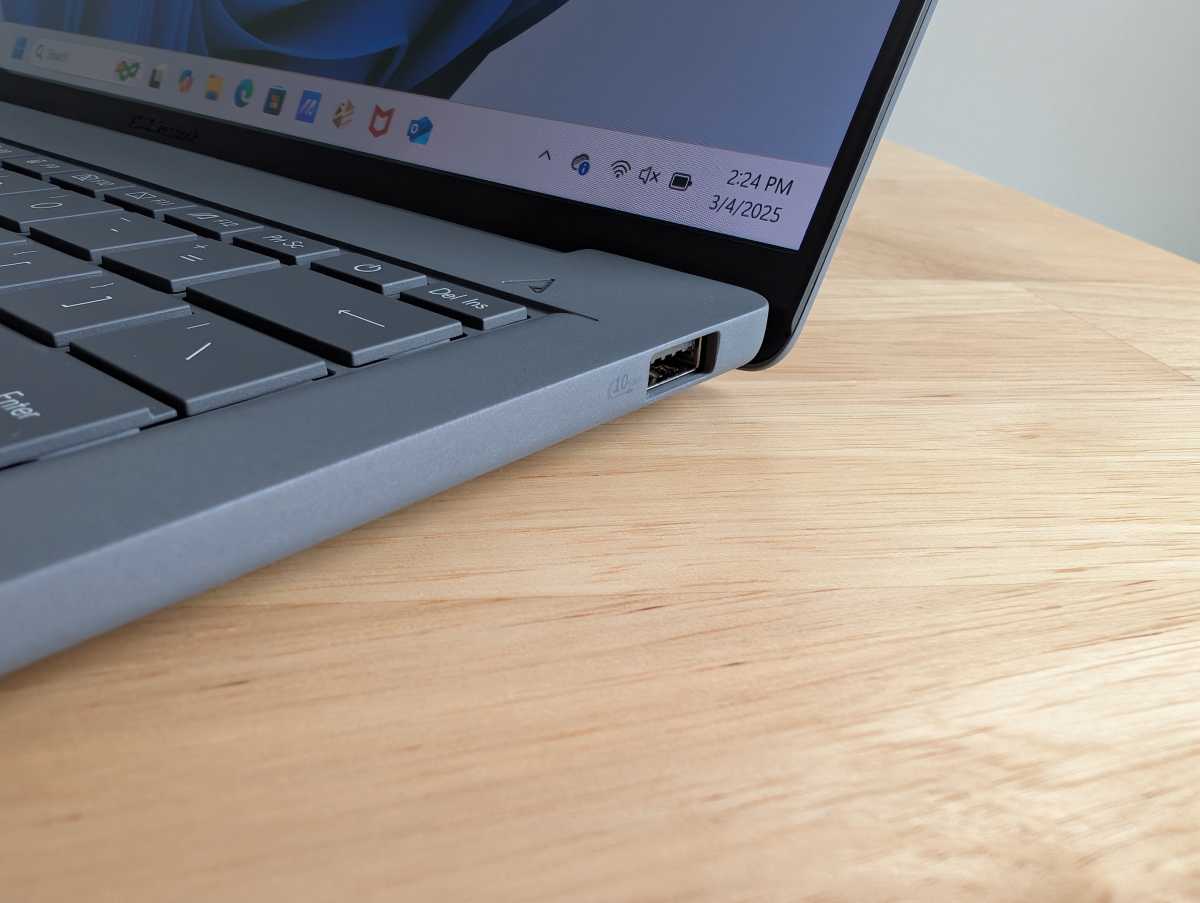
IDG / Chris Hoffman
The Asus ZenBook A14 has an adequate variety of ports, though they aren’t plentiful. This isn’t unexpected since it’s designed as an ultralight device. It’s pleasing to find a headphone jack included nonetheless.
On the left side of the device, you’ll see two USB Type-C ports, an HDMI output port, and a combined audio jack. Keep in mind that one of these USB Type-C ports must be used for charging since this device uses USB-C for power. The right side houses just a single USB Type-A port. These are all the connections available. Be sure to pack accordingly.
dongle
If your aim is to have additional ports.
Regarding the radios, you get the typical Snapdragon X setup with support for Wi-Fi 6E and Bluetooth 5.3.
Asus ZenBook A14: Performance
The Asus ZenBook A14 handled everyday desktop activities well. Given that this is an ultralight laptop equipped with a lower-end processor, I didn’t expect to run intensive CPU tasks on it! It managed browsing with Chrome and productivity software such as Microsoft Word just fine. However, when it came to graphics-intensive tasks—like gaming or using professional applications that stress the GPU—it fell short.
much
slower compared to numerous other systems powered by Snapdragon X Plus and Snapdragon X Elite processors
However, purchasing a $1,200 laptop is quite an investment, and you may later wish to undertake tasks that require more power than simply opening additional web browsers. This is why performance remains crucial.
As usual, we put the Asus ZenBook A14 through
our standard benchmarks
To evaluate its performance. However, as this is an ARM-based laptop, we’re unable to execute all of our usual benchmark tests.
Initially, we execute the Cinebench R24 test, featuring an optimized version for ARM architecture. This particular benchmark emphasizes comprehensive CPU performance through extensive use of multiple threads. Given its brevity, concerns about cooling during prolonged sessions do not apply here. However, due to its reliance on multi-threading, processors equipped with additional cores tend to perform significantly better.
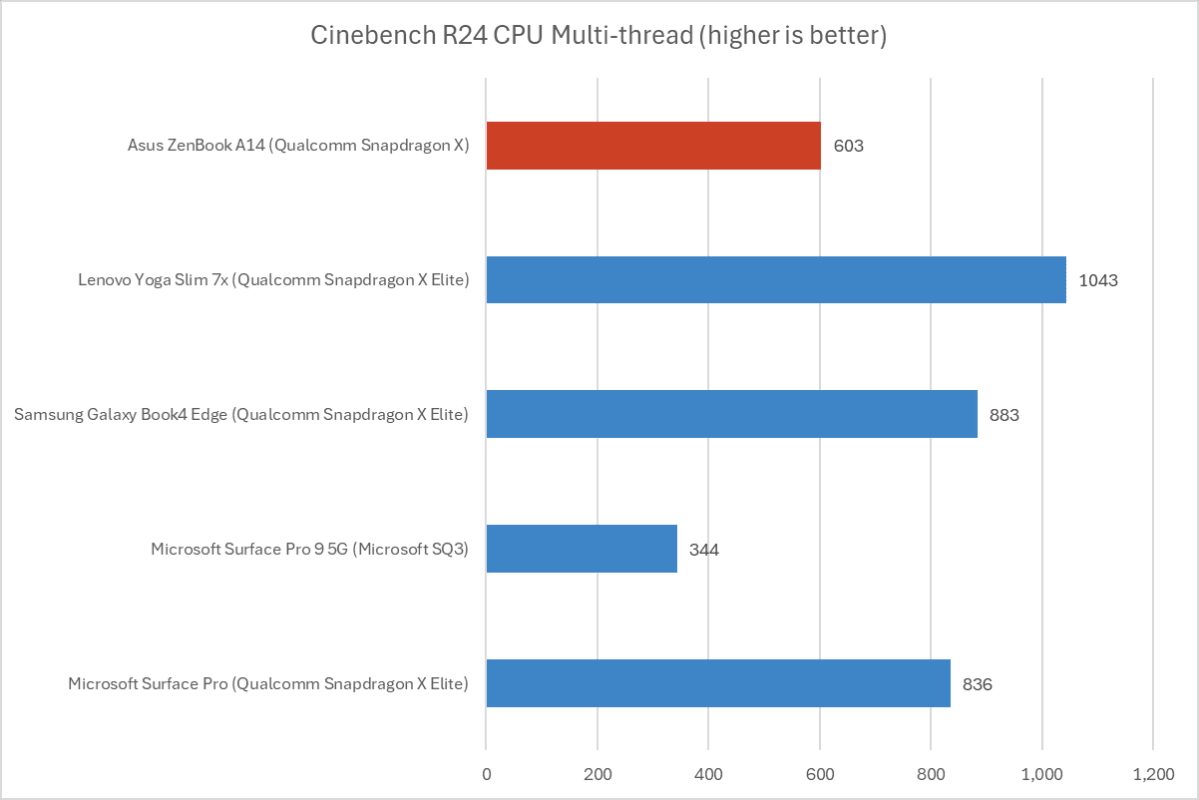
IDG / Chris Hoffman
What we observe here is this: The Asus ZenBook A14 achieves a multi-threaded Cinebench R24 score of 603, which places it significantly below the performance levels seen with devices powered by the Snapdragon XElite platform featuring twelve cores compared to its eight-core configuration.
Next, we perform a graphical benchmark test. This does not involve
gaming laptop
However, it’s still beneficial to assess the GPU’s performance. To do this, we execute 3DMark Time Spy, a graphics benchmark designed primarily for evaluating GPU capabilities. Although this test isn’t optimized for ARM architecture, it runs via the Prism translation layer. Consequently, this provides us with a reasonable indication of how well the system’s GPU will handle most Windows games, typically programmed for x86 CPUs and thus running through said translation layer.
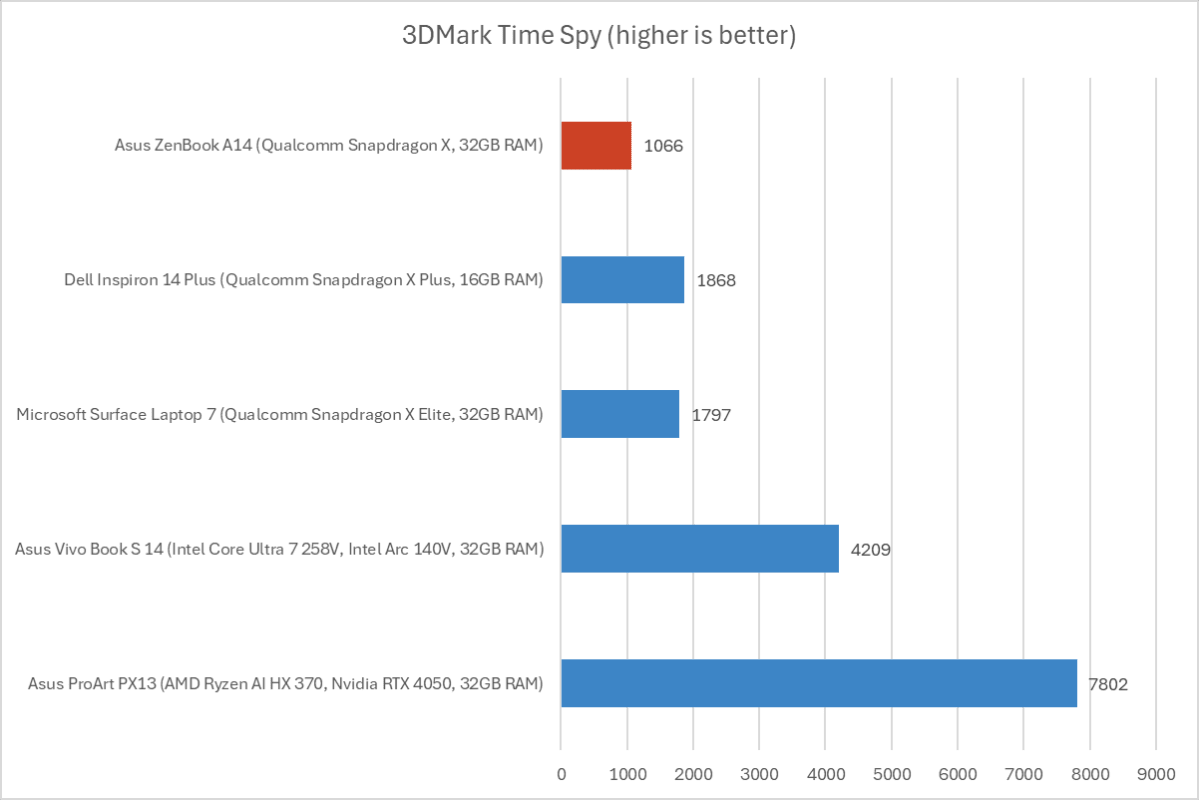
IDG / Chris Hoffman
Given a 3DMark Time Spy score of 1,066, the Asus ZenBook A14 underperformed compared to devices powered by the Qualcomm Snapdragon X Plus. While you likely won’t use this laptop primarily for gaming, it would be desirable if an $1,200 device offered superior GPU performance should you require it occasionally.
There are many other excellent laptop choices within this price range.
.
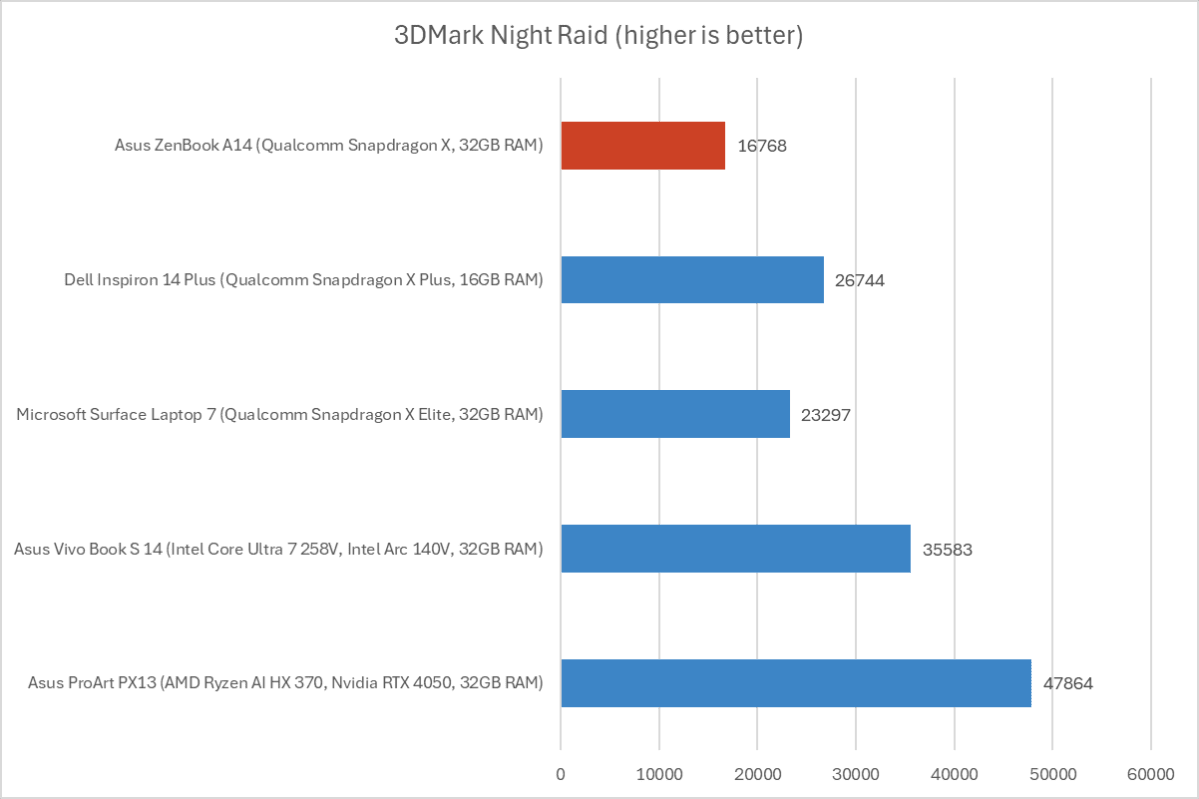
IDG / Chris Hoffman
We additionally execute 3DMark Night Raid, featuring an ARM-specific variant. This provides us with a clearer understanding of the device’s GPU capabilities, excluding the influence of the Prism translation layer.
Given a 3DMark Night Raid score of 16,768, the Asus ZenBook A14 falls significantly short compared to other devices powered by Qualcomm Snapdragon processors. It’s disappointing to witness such a capable laptop being hampered primarily due to its CPU selection at this particular price range.
In general, the Asus ZenBook A14 offers below-average performance within its hardware category and pricing bracket. However, it suffices for everyday desktop tasks.
fine
.
Asus ZenBook A14: Battery Performance
The Asus ZenBook A14 boasts a 70 Watt-hour battery, which is quite remarkable considering its featherweight at just 2.16 pounds. While they could have made it lighter for maximum portability, it’s great to observe such substantial power capacity. Given the device’s entry-level Snapdragon X chipset, we anticipate outstanding endurance from the battery.

IDG / Chris Hoffman
To measure the battery duration, we run a 4K version of
Tears of Steel
on repeat on Windows 11 with airplane mode enabled until the laptop suspends itself. This is a best-case scenario for any laptop since local video playback is so efficient, and real battery life in day-to-day use is always going to be less than this.
For our battery benchmark tests, we configured the screen to have 250 nits of brightness. It’s important to mention that the ZenBook’s OLED display holds a slight edge here because OLED panels consume less energy when rendering the dark areas surrounding videos.
The ZenBook A14 managed an impressive 1,436 minutes in our battery life test, equivalent to 24 consecutive hours on a single charge—a feat that seemed almost impossible not long ago. Although this figure comes from a synthetic benchmark which may differ from actual usage scenarios involving multiple open browser tabs and various apps, it indicates more battery life than the average user typically requires. In my opinion, the compromises in performance wouldn’t be justified for most individuals.
Asus ZenBook A14: Conclusion
The Asus ZenBook stands out due to its lightweight design and exceptional battery life. However, equipping it with the budget-friendly Snapdragon X processor seems odd for such an expensive device at $1,200. While it does offer extended battery duration, laptops of this caliber typically provide outstanding battery life anyway, so compromising on CPU power isn’t justified. Choosing a less costly CPU would likely result in significant savings. If you’re leaning towards going the ARM route, consider another model like the Snapdragon X-equipped alternative instead.
Surface Laptop 7
Almost every comparable device comes with a more advanced processor.
Nevertheless, there might be someone out there looking for an ultralight laptop designed to provide extended battery life without needing access to an electrical outlet. If that sounds like you, great news—you’ve just discovered your new go-to laptop.








